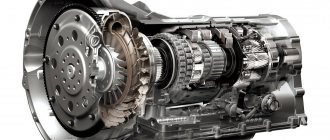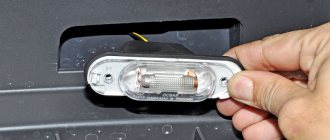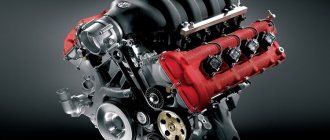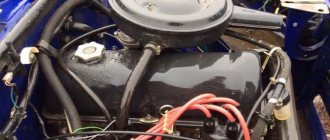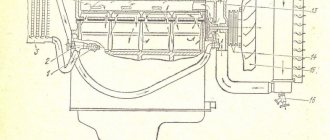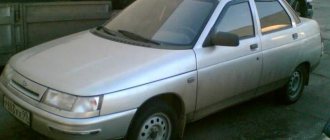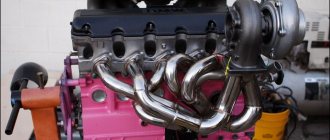Almost all parts and components of a car can be replaced relatively easily if necessary, even if we are talking, for example, about an engine and transmission. But what to do if a body part becomes unusable? There are fewer problems with the hood and doors, but how to replace the pillars or the bottom? But they are the ones who are most exposed to external factors: moisture, dirt, stone impacts. If a corrosion center has formed on the body, if you let the process take its course for a while, it will be extremely difficult to stop the spread of rust. Therefore, it is so important to provide comprehensive body protection, especially in those places that are not covered with factory paint. However, the paint coating cannot be called reliable protection against corrosion: a small scratch or an unnoticeable chip is enough for water, in contact with air and the metal surface, to lead to its oxidation.
There is a solution to the problem - coating body parts with a thin layer of zinc. Galvanization, performed in a factory, is considered the highest quality and most reliable protective agent against corrosion processes. You don’t have to look far for an example - the famous Audi, produced in the late 80s, that is, about thirty years ago, today will give a head start to much younger competitors when it comes to the condition of the body. Even though they have practically no components left that have not been restored or replaced, you can be sure that during all this time no body repairs have been carried out on such cars. So if you are planning to purchase a new or used car, you should ask in advance whether the body of this model is factory galvanized. It is this topic that we intend to examine with the utmost care.
Automotive galvanizing methods
For a polished but untreated steel structure, one rain is enough to start the oxidation process of the metal. The presence of several layers of paint and varnish will protect the surface from moisture, but who will protect the paintwork itself? With the lack of free space in modern cities, finding a car with an unscratched body is not an easy task. But even a small but deep scratch is enough for rust to appear in this place, spreading to nearby areas.
Therefore, metal surfaces exposed to active environmental influences are in dire need of additional processing. There are many methods for creating such a protective layer, but galvanizing is considered one of the most effective and affordable. It is the zinc-containing coating that provides the car body with optimal protective properties in most respects. Proof that cars with galvanized bodies suffer much less from metal oxidation is an increased warranty, the period of which for such cars can range from 6 to 25-30 years.
There are 6-7 methods of applying zinc coating to a steel surface, but only three of them are used in the automotive industry:
- hot galvanizing method;
- galvanic treatment of the vehicle body;
- cold galvanized.
Note that the latter method is used mainly in artisanal conditions. Automotive manufacturers prefer galvanization and hot-dip galvanizing, while the thermal method is considered more preferable in terms of reliability, quality and durability of the coating for the following reasons:
- with the hot processing method, the metal’s resistance to corrosion processes remains for a longer time (15 years or more, the thicker the zinc layer, the greater this indicator);
- it has been proven that the oxidation resistance of galvanized coating using heat treatment is approximately four times higher than that of the galvanic method;
- A hot-dip galvanized car body is much more resistant to various mechanical influences, maintaining this property throughout its entire service life;
- Such a protective zinc-containing coating is capable of regenerating (restoring) in local areas.
This means that a galvanized body is characterized by lower corrosion resistance. But if we talk about cold galvanizing, then this method is even less reliable and in most cases its indication in the technical characteristics of the car is purely for marketing purposes. It is believed that the zinc contained in the primer layer weakly protects the metal from oxidation in case of deep damage to the paint.
And in general, many automakers are lying when they report a galvanized body. In fact, it is important to know which method was used, since the anti-corrosion properties of body parts depend on this. In this case, only those parts of the body that are most susceptible to mechanical stress and therefore suffer from corrosion in the first place can be galvanized.
If you want to purchase a fully galvanized car , focus specifically on the word “full” - if it is not in the description, you can rest assured that we are talking only about partial anti-corrosion treatment.
Advantages and disadvantages
Galvanizing, despite its simplicity and reliability, has both advantages and disadvantages. Advantages:
- the machine is reliably protected from rust;
- The zinc layer is resistant to any weather conditions and can withstand significant
- mechanical damage;
- The corrosion protection time, based on the galvanizing method and operating conditions, is from 5 to 30 years.
Flaws:
- a very expensive procedure that requires certain skills and special equipment;
- galvanized body parts should not be harshly processed and cleaned;
- Even under ideal operating conditions of the machine, the zinc layer is gradually destroyed.
Hot galvanized vehicles
Since the method of galvanizing metal surfaces using the hot method is quite complex and requires the use of expensive equipment, it has a significant impact on the final cost of the car, and this fact must be taken into account. Few automakers are concerned enough about the anti-corrosion properties of their products to use this technology. Therefore, the list of cars with a hot-dip galvanized body is not so long. First of all, it is worth noting the cars of the VW Group, which has been using this technology for almost three decades. These are cars of the following brands:
- Porsche;
- VW;
- Audi;
- Skoda;
- Seat.
Is it possible to do galvanizing at home and what is required for this?
Galvanizing a car body with your own hands is quite possible, but it does not imply complete, but partial coating of certain elements with a protective layer. These may be areas that are most susceptible to corrosion: fender liners, sills, areas under the feet of the driver and passengers, door cards, as well as places where the paintwork is damaged.
The home method of applying zinc protection is something between cold and galvanic galvanization. But more on that a little later. And now about what is required for this.
Required tools and tools:
- latex gloves;
- zinc chloride or sulfate (soldering acid);
- a piece of zinc;
- glass vessel;
- car battery or charger;
- a piece of clean rag (gauze);
- sandpaper;
- degreaser (solvent);
- baking soda solution.
If you do not have the opportunity to purchase a ready-made zinc salt solution, you can prepare it yourself. To do this, take sulfuric or perchloric acid and dissolve pieces of zinc in it in a ratio of 1:0.4, i.e. for one liter of acid – 400 g. metal
This is done as follows. Pour acid into a glass container (glass, jar) and immerse zinc in doses until they stop interacting. The reaction occurs in the form of dissolution of the metal with the release of hydrogen. Therefore, be extremely careful: work with gloves and away from open heat sources. When the reaction stops, the solution can be considered ready. Filter it and drain the precipitate. Now you can begin the actual process.
Galvanized car
The main advantage of this technology over thermal processing methods is lower cost, so this method has become more widespread, and the list of car brands with galvanized bodies is much wider. It is most often used by Japanese and North American automakers, although it is also found in the Old World. Note that due to the lower efficiency of such coating, some European brands (we are talking about such giants as BMW and Mercedes) are working hard to improve the galvanic galvanizing method, using the following techniques to increase the anti-corrosion characteristics of their cars:
- For the manufacture of body parts, only high-alloy steel is used, characterized by a minimum content of impurities;
- provide a fairly thick layer of zinc (within 9-15 microns);
- treat the metal surface with a thick layer of primer and paintwork over zinc, using the improved adhesive properties of galvanized surfaces.
If we talk about the products of the Japanese automobile industry, then the quality of galvanizing is inferior to European ones, since local automakers began to use galvanizing much later than their European colleagues. Toyota cars deserve the most attention, which today have a fairly thick layer of zinc on all parts exposed to corrosion.
Now let’s look at which car bodies are galvanized using galvanic technology:
- Alfa Romeo (models that came off the assembly line after 1993);
- Mercedes W124/W201;
- Audi A4;
- Lexus;
- Mitsubishi (Lancer 9);
- Volkswagen (all models starting from 2000);
- Toyota (since 1991);
- Skoda (Fabia/Octavia models);
- Honda (Legend model only);
- Peugeot;
- Renault (Espace 3, Logan);
- Chrysler (model 300M).
Content:
- 1 Types of galvanization
- 2 Hot-dip galvanized vehicles
- 3 Galvanized models
- 4 Domestic equipment
Galvanization of elements acts as a panacea for such problems. It allows you to protect your car from an impressive list of damages. Let's figure out what it is, how it works, and who uses it.
Galvanized cars of domestic production
If we talk about the domestic automobile industry, then the situation with galvanizing the body is much worse. Previously, AvtoVAZ products were made from finished steel billets supplied from abroad. Some examples may indeed have been assembled from galvanized steel, but certainly not in large numbers. But even without anti-corrosion treatment, the cost of cars made from imported steel was too high, so AvtoVAZ employees switched to using local steel. Many body parts are galvanized, but this uses a cold process, which provides the least protection possible. In addition, this method involves galvanizing individual parts, and not the entire body, so we are not talking about complete protection.
Some components and parts are subjected to anti-corrosion treatment using the cataphoresis method without the use of zinc. Accurate information about the presence/absence of a galvanized layer on domestically produced cars is quite difficult to find. In relation to AvtoVAZ products, the list of models with a galvanized body is as follows:
- VAZ 2110 (about 30% of parts are galvanized);
- Lada 4x4 – only cataphoretic primer, no galvanized surfaces;
- Kalina (first generation - 52%, second - full galvanized, with the exception of the roof, side members and hood);
- Priora (29% since 2008, 100% since 2009);
- Granta (liftback – wings and doors are galvanized, sedan – without galvanization);
- Vesta – completely galvanized, except for the bottom/sills (the sedan’s roof is also not treated);
- XRAY – fully galvanized, except for the roof.
Cold galvanizing
The last method is cold galvanizing. This method is similar to the previous one in technology, but this one is even simpler and cheaper. Some car owners can process body parts using this method in their garages. The car does not need to be immersed in a special zinc-containing solution for this. The solution itself is applied to the body using an electrode, which is connected to the positive terminal (the car body is connected to the negative terminal). Some car repair shops offer a service for processing car body parts, but complete processing cannot be done this way. Since this method is not used by car manufacturers, it is not worth describing it in detail.
How to find out whether a car is galvanized or not
So, if you want to own a car with a galvanized body and are willing to pay a little extra for it, you will need an accurate way to find out whether a particular model has been subjected to such treatment. Moreover, this is true for both new and used cars (in the second case it is even more significant). Unfortunately, we would not recommend taking the word of sellers, even if they are representatives of a well-known brand car dealership. The first thing you need to do is look at the technical characteristics of the machine. If you haven’t come across the word “galvanization”, you can say with confidence that there is practically no anti-corrosion protection for body parts. But even otherwise you need to be careful. Only the presence of the phrase “full galvanization” suggests that the entire body was processed, and not its individual elements.
Partial galvanization is practiced much more often; most models produced today have just such incomplete protection of the body from moisture. The lower the cost of a car with the same equipment, the worse its ability to resist oxidation - galvanizing, priming and paintwork on budget cars is carried out using the most affordable materials and technologies. Economy class models from Asian automakers are especially guilty of this. Unfortunately, it is not possible to independently determine whether the body is galvanized or not. To do this, you need to use a fairly expensive technique, which even many large service centers cannot afford. You can subject the car to galvanization testing, but its cost may be so high that there will be little point in this step.
From the above material, it can be assumed that the bodies of many European, Asian and American-made cars are processed using the galvanic method. Thermal technology is less common, but recently, thanks to the efforts of German manufacturers, the cost of such galvanizing has been steadily decreasing, approaching the cost of the galvanic method. Note that we did not mention another method of applying zinc to a steel surface. Zinc metal technology does not have good tread properties, so few manufacturers use it - in particular, the Korean company Kia.
When purchasing a new car, among other documents, you receive a warranty card, which states the warranty period against through corrosion of the car body. We advise you to treat this piece of paper with special attention - if body defects appear during the warranty period, you can save a considerable amount of money on restoring the integrity of the body part damaged due to poor processing, and in some cases you can even replace the defective car with another.
Summarizing the above, we note that the main source of information about body galvanization is the technical documentation for a specific model, as well as the availability of an appropriate warranty. Technical verification methods exist, but they are complex, expensive and therefore cannot be ordered everywhere. We also note that you should not trust advertising materials - the level of marketing today is very high, and manufacturers resort to numerous tricks, citing facts that turn out to be only partial truth, or even completely misinformation.
Let's sum it up
Now we know which cars have a galvanized body. The lists are gradually increasing as manufacturers are able to use proven and inexpensive methods, for example, adding zinc to primer or paint. Therefore, you need to take into account some nuances highlighted by auto experts:
- Reliable protection of the vehicle body by galvanizing is possible only with expensive models, since investing in budget options is considered unwise - they simply will not pay for themselves.
- In the modern world, the level of body preparation is much worse than it was 10-20 years ago. While cars produced in the 1990s were built to last for decades, today this period has been reduced to 7 years, after which the car can be scrapped. Therefore, you should not believe dealers who claim that the service life of any new model is at least 10 years, because its body is galvanized - this is a marketing ploy, nothing more.
- In the technical specifications, any manufacturer may indicate that the machine is galvanized, although in fact it is not. At least this applies to the already mentioned budget models, when only some body elements were subjected to this procedure.
Galvanizing method using “white powder”
For more efficient processing of metal with zinc, soldering acid is used instead of phosphoric acid. This is hydrochloric acid diluted with water with zinc dissolved in it. According to craftsmen, galvanizing with a similar composition lasts longer and penetrates deeper into the metal surface. Soldering acid is sold in radio equipment stores in small bottles. It can also be made by diluting zinc chloride, a white powder that is sold by weight.
Main stages of work
First, you need to pour zinc chloride into a strong container, pour in distilled water to get a clear liquid. Approximately 2.5 liters are needed per kilogram of product. You can put the entire part into the finished soldering acid, creating a galvanic bath. Before starting work, you should clean the product from rust with sandpaper or a grinder, and then activate the metal - remove the oxide film from its surface.
Metal activation
During activation, the positive terminal of the battery is connected to the part, the negative terminal is connected through a 20-watt light bulb to the electrode (an iron bolt wrapped in a cotton rag and soaked in soldering acid). As current is applied, the product will be cleaned of the oxide film. Only after its removal is the metal immersed in a galvanic bath and galvanizing is carried out in a similar way.
Cooling radiator
Troubles are also possible with him. They can be caused by three reasons:
- The most harmless option: wait until it cools down, the traffic jam is over - and you drive on with a light heart;
- the core is clogged inside with refrigerant deposits or dust. The pressure through the radiator drops, cooling is insufficient;
- scale and deposits in the pipes. The thermal conductivity of the hoses decreases, and the liquid does not have time to cool again.
Except the first option
Water pump:
It most often fails in those machines where torque is supplied to the pump pulley separately from the gas distributor. The pulley rotation speed may decrease if the drive belt is loose (stretched). After making sure that your thermostat is normal, try tightening the belt and driving after the engine has cooled and topped up the coolant.
Fan:
If the fan is killed, this is the easiest reason to determine. Even if the car does not have a corresponding sensor warning that the fan is not working, a person who is not behind the wheel for the first time will hear it by sound. In the city and slowly, with a non-working fan, you can get to a repairman. Outside the city, we are looking for a tug.
